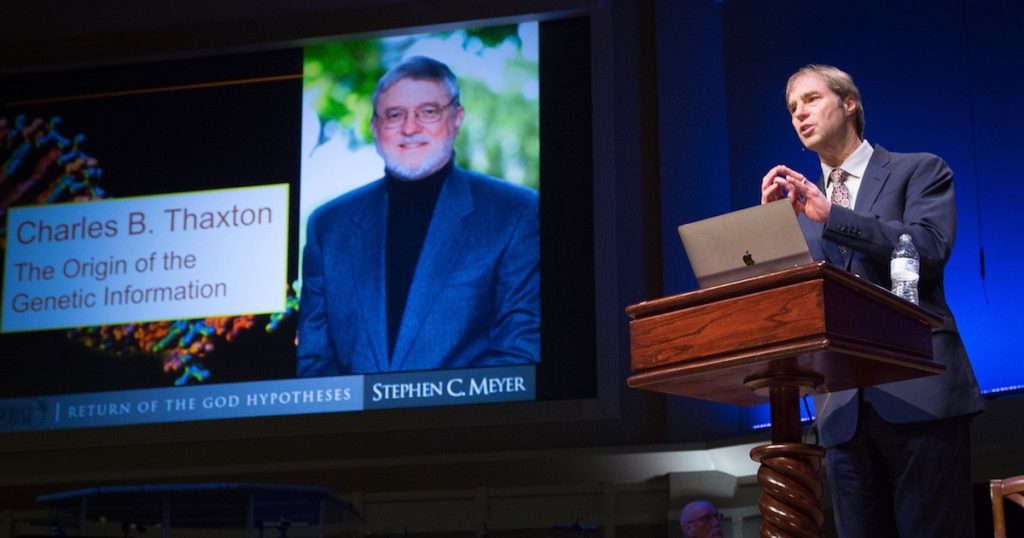Stephen C. Meyer shares, from the Foreword to the new memoir by Charles Thaxton, A Leg to Stand On:
I first met Charles Thaxton after a conference in 1985. Little did I know at the time that meeting him would change the entire direction of my life.

The conference, titled “Christianity Challenges the University: An International Conference of Theists and Atheists,” convened in Dallas, Texas, in February of that year. It featured panels of scientists from competing philosophical perspectives discussing three big scientific and philosophical questions: the origin of the universe, the origin of life, and the nature of human consciousness.
During a session on the origin of life, the scientists discussed a question I had never considered: Where did the information stored in the DNA molecule come from?
On February 10, 1985, I learned I wasn’t the only one. On that day I found myself sitting in front of eight world-class scientists, who were discussing the vexing scientific and philosophical question: How did the first life on earth arise?
What introduced drama into what might have otherwise been a dry academic discussion was the reaction of some of the scientists to a new idea. Three of the scientists on the panel had just published a controversial book called The Mystery of Life’s Origin, with a prominent New York publisher of scientific monographs. Their book provided a comprehensive critique of the attempts that had been made to explain how the first life had arisen from the primordial ocean, the so-called “pre-biotic soup.” These scientists — Charles Thaxton, Walter Bradley, and Roger Olsen — had concluded that all such theories had failed to explain the origin of the first life. Surprisingly, the other scientists on the panel — all experts in the field — did not dispute this critique.
The Code of Life
What the other scientists did dispute was a controversial new hypothesis Thaxton and his colleagues had floated in the epilogue of their book in an attempt to explain this DNA enigma. Thaxton et al. had suggested the information in DNA might have originated from an intelligent source, or as they put it an “intelligent cause.” Since, in our experience, information arises from an intelligent source, and since the information in DNA was, in their words, “mathematically identical” to the information in a written language or computer code, they suggested the presence of information in DNA pointed to an intelligent cause. In other words, the code of life pointed to a programmer.
That was where the fireworks started. Other scientists on the panel became uncharacteristically defensive and hostile.
[It] was also clear, to me at least, that the authors of the new book had seized the intellectual initiative. They had offered a bold new idea that seemed at least intuitively plausible, while those defending the status quo offered no alternative to their new explanation.
A Mystery Story
I left deeply intrigued. If Thaxton’s portrayal of the scientific status of the problem was accurate — if there was no accepted or satisfactory theory of the origin of the first life — then a mystery was at hand. And if it was the case that evolutionary theory could not explain the origin of the first life, because it could not explain the origin of the genetic information in DNA, then something we take for granted was quite possibly an important clue in a mystery story.
DNA with its characteristic double-helix shape is a cultural icon. We see the helix in everything from music videos and modern art to science documentaries and news stories about criminal proceedings. We know DNA testing can establish guilt, innocence, paternity, and distant genealogical connections. We know DNA research holds the key to understanding many diseases, and manipulating DNA can alter the features of plants and animals and boost food production. Most of us know roughly what DNA is and what it does. But could it be that we do not know anything about where it came from or how it was first formed?
If Thaxton was right, then the classical design argument that had been dismissed first by Enlightenment philosophers, such as David Hume in the 18th century and then later by evolutionary biologists in the wake of the Darwinian revolution, might have legitimacy after all.
Could the design argument be resuscitated based upon discoveries in modern science? And was DNA the key?
My discussion of these questions changed the course of my professional life. By the end of that year, I was preparing to move to the University of Cambridge in England to investigate questions I first encountered earlier that February and in my subsequent discussions with Charles. During my PhD research, I investigated several questions that had emerged in my discussions with Thaxton. What methods do scientists use to study biological origins? Is there a distinctive method of historical scientific inquiry? Could the argument from DNA to design be formulated as a rigorous historical scientific argument?
Intelligent Cause, Intelligent Design
Years later, after completing a PhD on the topic of origin-of-life biology, I would write my own book on the subject of the origin of life and intelligent design. My book, Signature in the Cell, built directly on the critique of chemical evolution that Charles and his co-authors had developed in The Mystery of Life’s Origin. It also further developed the positive case for an intelligent cause, or what we now call “intelligent design,” as the best explanation of the information in DNA — in other words, the same hypothesis Thaxton and his colleagues first proposed in the epilogue to Mystery.
Full article at Evolution News.